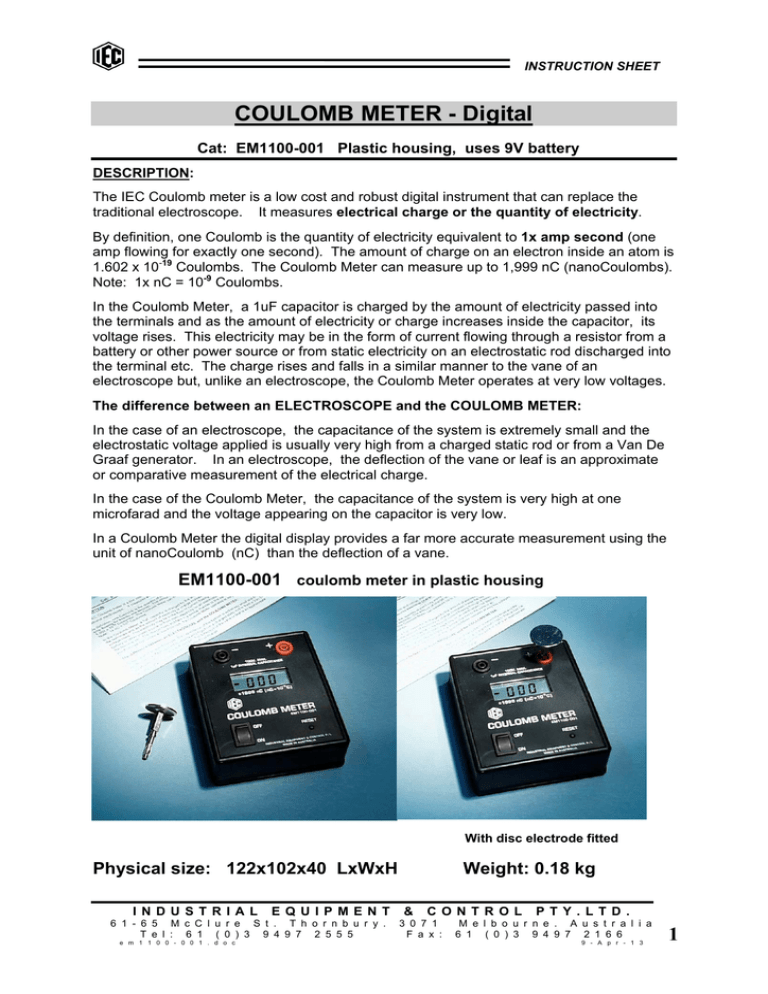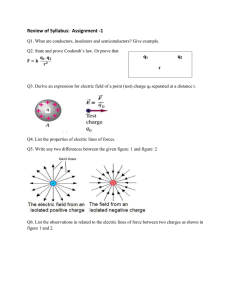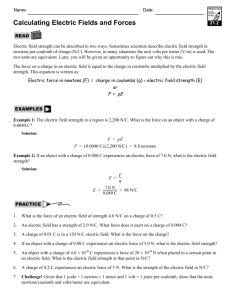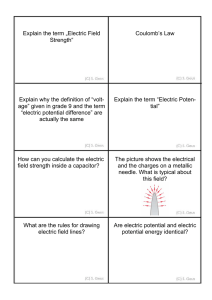COULOMB METER - Digital
advertisement

INSTRUCTION SHEET COULOMB METER - Digital Cat: EM1100-001 Plastic housing, uses 9V battery DESCRIPTION: The IEC Coulomb meter is a low cost and robust digital instrument that can replace the traditional electroscope. It measures electrical charge or the quantity of electricity. By definition, one Coulomb is the quantity of electricity equivalent to 1x amp second (one amp flowing for exactly one second). The amount of charge on an electron inside an atom is 1.602 x 10-19 Coulombs. The Coulomb Meter can measure up to 1,999 nC (nanoCoulombs). Note: 1x nC = 10-9 Coulombs. In the Coulomb Meter, a 1uF capacitor is charged by the amount of electricity passed into the terminals and as the amount of electricity or charge increases inside the capacitor, its voltage rises. This electricity may be in the form of current flowing through a resistor from a battery or other power source or from static electricity on an electrostatic rod discharged into the terminal etc. The charge rises and falls in a similar manner to the vane of an electroscope but, unlike an electroscope, the Coulomb Meter operates at very low voltages. The difference between an ELECTROSCOPE and the COULOMB METER: In the case of an electroscope, the capacitance of the system is extremely small and the electrostatic voltage applied is usually very high from a charged static rod or from a Van De Graaf generator. In an electroscope, the deflection of the vane or leaf is an approximate or comparative measurement of the electrical charge. In the case of the Coulomb Meter, the capacitance of the system is very high at one microfarad and the voltage appearing on the capacitor is very low. In a Coulomb Meter the digital display provides a far more accurate measurement using the unit of nanoCoulomb (nC) than the deflection of a vane. EM1100-001 coulomb meter in plastic housing With disc electrode fitted Physical size: 122x102x40 LxWxH I N D U S T R I A L E Q U I P M E N T 6 1 - 6 5 M c C l u r e S t . T h o r n b u r y . T e l : 6 1 ( 0 ) 3 9 4 9 7 2 5 5 5 e m 1 1 0 0 - 0 0 1 . d o c Weight: 0.18 kg & C O N T R O L 3 0 7 1 F a x : P T Y . L T D . M e l b o u r n e . A u s t r a l i a 6 1 ( 0 ) 3 9 4 9 7 2 1 6 6 9 - A p r - 1 3 1 INSTRUCTION SHEET IMPORTANT NOTES: CONNECTIONS: When depositing electric charge into the Coulomb Meter, a cable can be used from the positive terminal to the charged source …. For example, a Van De Graaf generator. But if charged rods or Proof Planes are being used, it is best to use the flat charge disc provided with the instrument. Using this disc reduces the unwanted ‘leakage’ or loss of charge into the atmosphere. THE NEGATIVE TERMINAL: The capacitor being charged inside the Coulomb Meter is connected between the positive and negative terminals, therefore, the negative terminal should be connected to any earthed point or to a metal plate on the work bench, or the metal banana plug on a cable can be simply held in the user’s hand. The reason is that the static charge being deposited into the Coulomb Meter is relative to earth potential. If the negative terminal is “floating” to be at any random potential, the whole electric charge will not deposit into the capacitor. • • • • • Charge is accumulated on a 1uF capacitor contained within the Coulomb Meter. Before applying the first electric charge, always reset the display to zero. When adding or subtracting charges, do not reset the display. Charges can be added to existing charges so that the display will show total nC. Full scale reading occurs when sufficient charge has been accumulated in the capacitor to produce a 2V P.D. (potential difference) between the + and - terminals. The maximum voltage that may be directly connected between the + and terminals is 100V. A higher voltage may cause internal damage to the Meter. EXPLANATION OF ‘MAXIMUM VOLTAGE’: We know that the static charge residing on an acrylic rod or a Proof Plane can be thousands of volts. So, why does this very high voltage not damage the Coulomb Meter ? A charged electrostatic rod carries a potential of several thousand volts but, since the capacitance of the rod is extremely small compared to the 1uF capacitor, the number of coulombs available from the rod is extremely small. When this charge on the rod is deposited into the 1 uF capacitor of the Coulomb Meter, the voltage on the capacitor will rise only a small fraction of a volt. To damage the Coulomb Meter, the voltage would need to be in excess of 100 volts and the energy available would need to be enough to fully charge the 1uF capacitor. This is unlikely to occur with experiments in electrostatics. ADDITIONAL PARTS SUPPLIED: • • 1 pce 25mm Diameter Collector Plate to fit the 4mm socket. 1 pce 9V Battery (PP3) To fit new battery, remove bottom panel. Designed and manufactured in Australia I N D U S T R I A L E Q U I P M E N T 6 1 - 6 5 M c C l u r e S t . T h o r n b u r y . T e l : 6 1 ( 0 ) 3 9 4 9 7 2 5 5 5 e m 1 1 0 0 - 0 0 1 . d o c & C O N T R O L 3 0 7 1 F a x : P T Y . L T D . M e l b o u r n e . A u s t r a l i a 6 1 ( 0 ) 3 9 4 9 7 2 1 6 6 9 - A p r - 1 3 2



